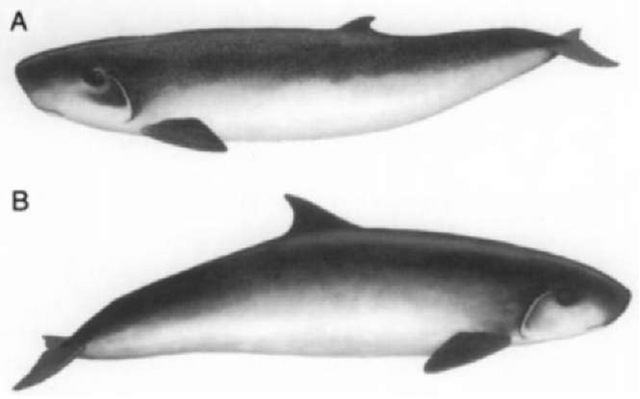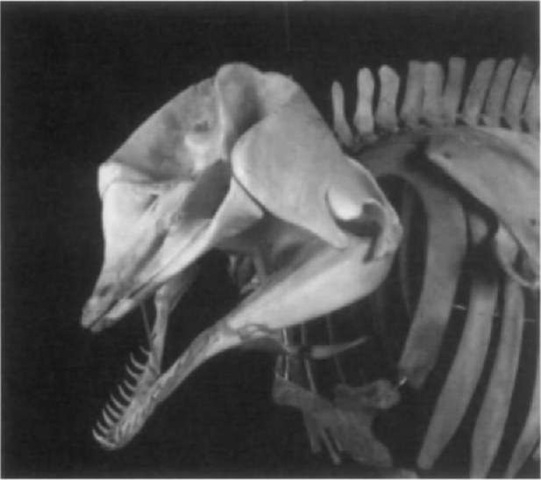Found throughout temperate and tropical seas, pygmy and dwarf sperm whales are small, toothed cetaceans generally assigned to the family Kogiidae. Although rarely sighted at sea, these whales commonly strand in some regions. The relatively little that is known of their biology has been gleaned from such stranded animals.
I. Diagnosis
In form, Kogia spp. are porpoise-like and robust with a distinctive underslung lower jaw. This latter feature has been described as giving these whales a shark-like appearance (Fig. 1). Although height and position of the dorsal fin have been reported as distinguishing the two species, they are probably not separable at sea except under exceptional circumstances. Pygmy sperm whales reach a maximum size of about 3.8 111 total length and a weight of 450 kg. Dwarf sperm whales are smaller at 2.7 m and 272 kg. Adults of both species are dark bluish-gray to blackish-brown dorsally with a light venter. On the side of the head between the eye and the flipper there is often a crescent-shaped, light-colored mark referred to as a “false gill.” It is only since 1966 that two species of Kogia have been recognized, and no subspecies have been described. Some cetologists place Kogia in a subfamily Kogiinae within Physeteridae with the sperm whale, Physeter macrocephalus. Some anatomical features suggest that the relationship between Kogia and other toothed whales remains poorly resolved.
II. Distribution and Status
Dwarf and pygmy sperm whales occur worldwide in temperate and tropical waters of the Atlantic. Pacific, and Indian Oceans. Evidence shows that K. sima may prefer warmer seas than K. breviceps, but currently there is little indication for seasonality in the distribution or the migration of these whales. Their precise at-sea distribution is unknown, as most records are based on stranded animals. Although many writers have stated that dwarf and pygmy sperm whales are rare, there is insufficient information to classify the world status of Kogia species, and their population sizes are unknown. The frequency with which Kogia strand on certain coasts, especially in southeastern United States and South Africa, suggests that they may be uncommon rather than rare in some regions.
III. Ecology
Analysis of prey in stranded animals suggests that both species of Kogia generally inhabit waters along the continental shelf and slope in the epi- and mesopelagic zones. Differences in the proportion of prey items in stomachs indicate that K. sima feeds in shallower water than K. breviceps. Kogia spp. feed mostly on mid and deep-water cephalopods but also consume fish and occasionally crustaceans, such as shrimp and crabs. Stomach contents that have been analyzed have contained cephalopod beaks from at least 13 families. Most feeding seems to takes place on or near the bottom, probably using echolocation to find prey. Kogiid hyoid anatomy suggests powerful suction feeding.
Figure 1 (A) Kogia breviceps. The relatively short and more posteriorly positioned dorsal fin is useful in distinguishing this species from (B) K. sima.
Little is known about disease in Kogia. Strandings of unhealthy pygmy and dwarf sperm whales have been attributed to degenerative heart disease, as well as being linked to possible immune system problems associated with the thymus gland. Pneumonia has also been observed in stranded animals. Kogia specimens are frequently heavily infected with intestinal nematodes (Anisakis sp. and Terranova cetecola) and blubber-encysted larval cestodes (Phtjllobothrium delphini). The parasitic crustacean, Pennella bal-aenoptera, has been observed embedded in the epidermal surface of both species of Kogia. Scaning indicates that these whales are attacked by lampreys. A white shark (Carcharadon carcharias) attack on a pygmy sperm whale has been documented, and pygmy sperm whale remains have been identified in killer whale (Orci-mis orca) stomachs. Levels of predation on Kogia are otherwise unknown. Heavy infestations with larval cestodes, wliich probably mature in elasmobranchs, suggest that shark attacks may be more common than the single literature report suggests.
IV. Behavior
There have been no comprehensive behavioral studies of dwarf or pygmy sperm whales. Stranded animals that have been maintained in aquaria have survived no more than several months and usually only live for a few days. At sea, both species occur individually or in small groups of up to 6 (K breviceps) or 10 (K. sima) animals of varying age and sex composition. Strandings usually involve single animals. Dwarf and pygmy sperm whales are reported to spend considerable time lying motionless at the surface with the back of the head exposed and the tail hanging down. K. breviceps is easily approached, but is timid and slow moving. Normal swimming speed is thought to be about 3 knots. When surfacing, both species rise slowly, produce an inconspicuous blow, and dive without showing the flukes. Neither species is known to be highly vocal.
V. Anatomy and Reproduction
The genus has the shortest rostrum among living cetaceans (Fig. 2) and the skull is markedly asvmetrical. The mandibles are delicate, and the teeth are very sharp, thin, and lack enamel. K. breviceps lacks teeth in the upper jaw, but K. sima may have up to three pairs of vestigial teeth in this position. Like the Physeteridae, Kogia spp. have a spermaceti organ. The function of this organ is unknown, but it has been suggested that it may be involved in maintaining neutral buoyancv or function as an acoustic lens in directing sound beams during ecolocation. K. sima reaches sexual maturity at about 2.1 m in length. In K. breviceps, males are known to be sexually mature at about 2.7 m and females at a slightly smaller size. Gestation has been cited as 9 or 11 months, with the species about 1 m in length at birth.
Figure 2 Skull of Kogia breviceps. The rostrum is short, the skull asymmetrical, and teeth are lacking in the upper jaw.
VI. Fossil Records
Fossil forms of Kogiidae have rarely been described from fragments of teeth, cranium, and lower jaws of late Miocene to early Pliocene age. Most of these may be only distantly related to extant Kogia spp. However. Praekogia cedrosensis, described from the early Pliocene in the Almejas Formation on Isla Ce-dros Baja California, Mexico, is reported to be clearly ancestral to living Kogia.
VII. Human Interactions
The scarcity of pygmy and dwarf sperm whales and the fact that they are rarely encountered at sea mean that direct effects from humans are probably few. However, they have been reported to ingest ocean debris such as plastic bags, possibly resulting in intestinal blockage and death. Their habit of lying quietly at the surface seems to have led to occasional ship strikes. Both species are taken infrequently in commercial harpoon fisheries in the Caribbean and Indian Oceans.


